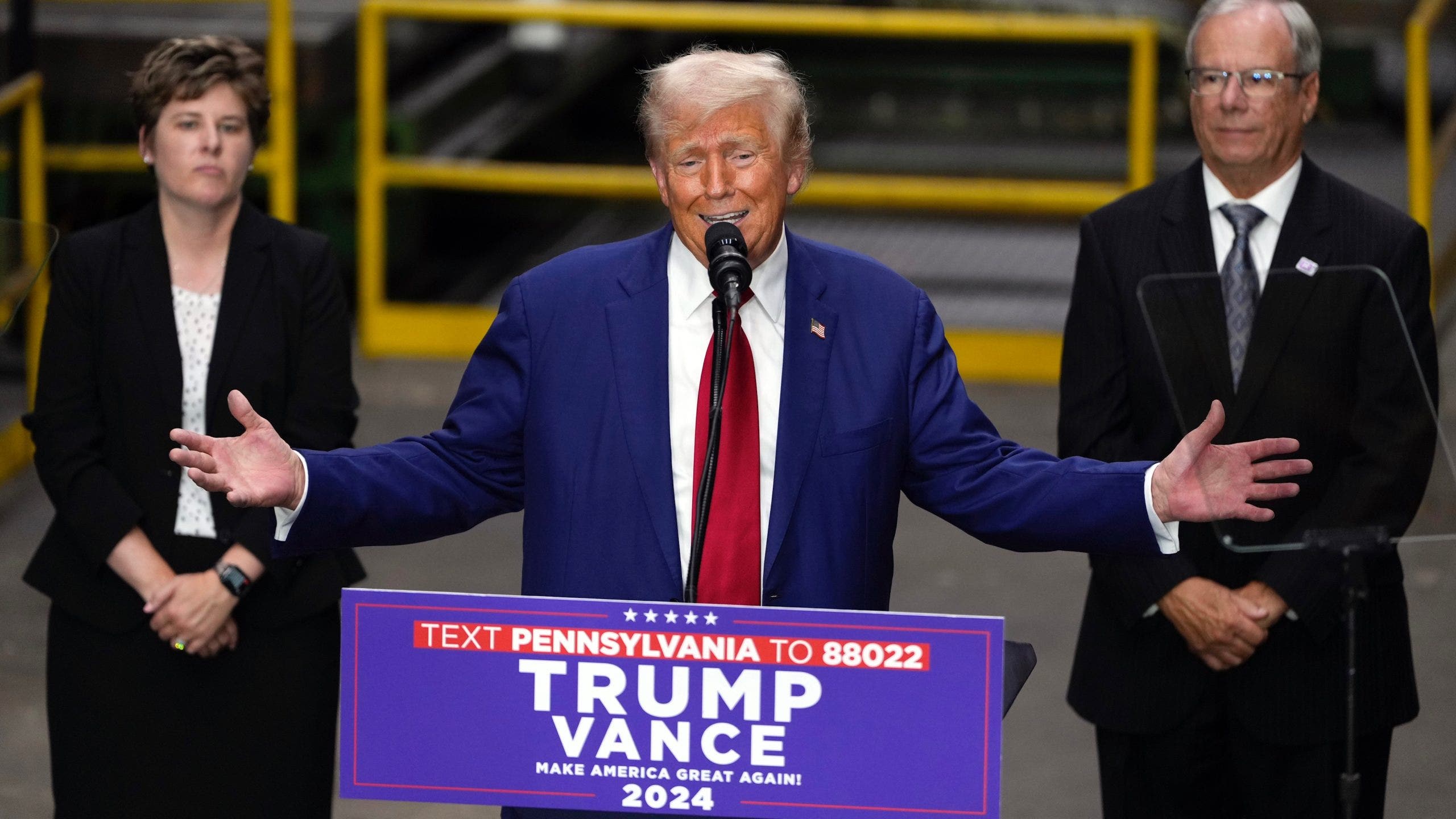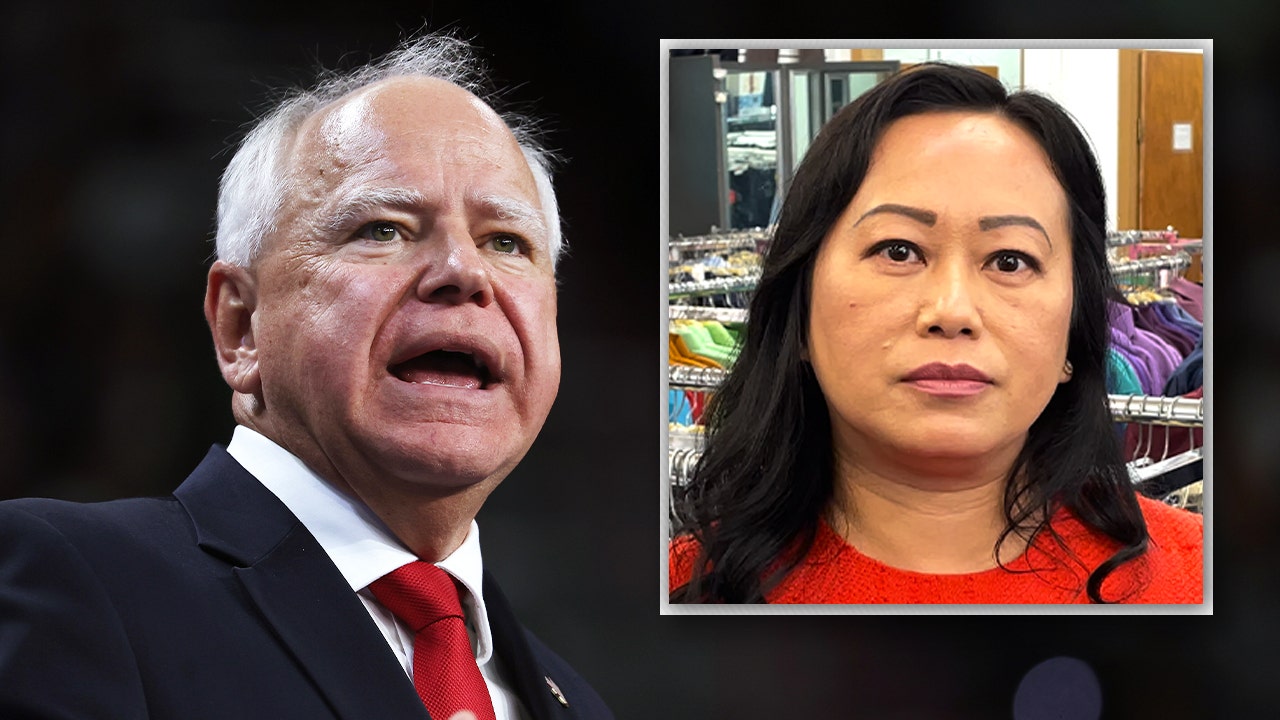Lifestyle
With the DNC underway, a historian explains how 'The Stadium' became a public square

President Biden speaks during the Democratic National Convention Aug. 19, 2024, in Chicago’s United Center Stadium.
J. Scott Applewhite/AP
hide caption
toggle caption
J. Scott Applewhite/AP
On Monday night, around 50,000 people filled the Chicago United Center as President Joe Biden addressed the Democratic National Convention. Columbia University historian Frank Andre Guridy says these massive monuments to sports, entertainment and politics serve as public squares in American culture.
In his book, The Stadium: An American History of Politics, Protests, and Play, Guridy chronicles the role that arenas have played in American history and culture. From a 1920s pro-Nazi rally at Madison Square Garden, to Colin Kaepernick taking a knee in 2016 to protest police brutality, Guridy says that stadiums are where Americans battle over race, class, gender and sexual inequities.
“We fight our political battles in stadiums,” Guridy says. “Because they’re large, because they can accommodate all sorts of people, … they become ideal places to stake your claims on what you want the United States to be.”
Guridy says the country’s first “stadiums” — which took the form of circus tents or wooden ballparks — arose in the late 19th and early 20th centuries and were typically funded by entrepreneurs. In recent decades, however, there’s been a trend toward taxpayer-funded stadiums — though Guridy notes: “This notion that stadiums are places that help generate economic development … [has] been debunked over and over and over again.”

Guridy adds that as more stadiums are built or replaced, they are becoming increasingly generic, with corporate names and a cookie-cutter-style. “I would argue that most of these facilities feel like no place, because they all have the same sort of arrangement of ads and same types of scoreboards, same sorts of rituals,” he says. “They all look the same.”
Interview Highlights

The Stadium
Porchlight Books
hide caption
toggle caption
Porchlight Books
On how it came to be that taxpayers pay for new stadiums
Franklin Roosevelt’s New Deal helps begin the process by which public funds are building stadiums. … But it isn’t until after World War II, when we see the exploding growth of both the sport and the entertainment industry. When the United States really becomes a nationally sports-crazed nation, where sports franchises start to make the case to politicians that … if you want to have a team in your city, you need to build a stadium for us. And politicians discover that they can gain a lot of political capital by bringing a major league team to the city. And that accounts for the exploding growth of publicly financed stadiums in the 1960s and ‘70s, and really, until this day. …
Because sports leagues are de facto — and also legislatively — monopolies in the United States, they can command that sort of power. It’s become this kind of convergence between aspiring politicians and sports leagues that have been able to make the case that, in fact, the stadium is something that should be funded by taxpayer public funds.
On the role stadiums played in the country’s desegregation
Ballparks like Ebbets Field [in Brooklyn] become places of this enormous cultural and social and political transformation. Now, it’s not just because Jackie Robinson shows up in a Brooklyn Dodger uniform. It’s because people have been agitating for the desegregation and the elimination of Jim Crow for decades. … And we see this all across the country, particularly in the South when … the college football stadium becomes this kind of shrine, this temple, that is designed in part to not just stage football games, but to actually exemplify and celebrate the Jim Crow South and its imagined legacy in the Confederacy and slavery.
Stadiums up until the mid 20th century, particularly in the South, were all-white affairs, or certainly designed to sort of exclude people of African descent and non-white people. But because of the impact of the freedom movements across the South and in other parts of the country, we see this major shift playing out in public at stadiums across the country. So Americans are able to experience that, live, at your local facility.
On how the American national anthem and flag became part of stadium culture

It starts in the early 20th century, where we start to see performances of Francis Scott Key’s anthem in public places. But it isn’t till 1931 when it becomes the national anthem, and it really isn’t till the 1940s, where we start to see the kind of regular performance of “The Star-Spangled Banner” before sporting events … not coincidentally, in the aftermath of wars, in the aftermath of World War I, in the aftermath of World War II. And then later on, we start to see the proliferation anthems like “America the Beautiful” and others performed after 9/11, in moments, not coincidentally, where the United States is at war, when the U.S. government really has to make the case of national loyalty to its citizens, and the ballpark and the stadium and the arena becomes one of those places where that loyalty is cultivated.
On the militarized nationalism of stadium culture, and Colin Kaepernick’s protest of police brutality in 2016

By the time Kaepernick takes his knee at Qualcomm Stadium [in San Diego] in August 2016, eight years ago, you, at that point, had 15 years of jet flyovers. Fifteen years of honoring the military and law enforcement. And that’s the thing that’s interesting after 9/11: The ways in which these, you know, celebrations of the military become celebrations of law enforcement, which [happens] almost immediately, partly because of those who died among the first responders at the Twin Towers, but it’s more than that. It becomes a policy of pushing pro-police politics, I would argue, across the country. By the time Kaepernick does what he does, it’s now 15 years of that in which patriotic expression is narrowed and dissent is less tolerated in public.

Certainly athletes have been persecuted before Colin Kaepernick — most famously Tommie Smith and John Carlos when they make their Black Power salute at the 1968 Olympic Games in Mexico City. … But you do see the absolute intolerance and the vilification of Colin Kaepernick, which I would argue was unprecedented, and I think it’s because we have converted the stadium into a pep rally for the military and for law enforcement. Just the questioning of any sort of police action becomes intolerable, especially when a Black athlete does it. …I think that that’s why the stadium becomes this interesting theater, to look at the way in which we make sense of our world and of American politics. And I definitely think that there’s a much more repressive political culture that ensues after 9/11 than what existed before.
On the “Gay Games,” in part as a response to homophobia within stadiums

One of the most famous cases or infamous cases of [homophobia in a stadium] was the 1979 Disco Demolition event that happened at Chicago’s Comiskey Park, in which a local disc jockey, Steve Dahl, decided to create the ceremony in the middle of a baseball doubleheader to blow up disco records. And this is at a moment when the kind of anti-disco movement was emerging in the United States and [it] was very much an anti-gay movement. It was very much fueled by homophobia and racism. … That event turns into a riot where literally people charged the field and the games are canceled. The second game of the doubleheader was canceled on that evening in 1979 in Chicago.
So the ballpark becomes this battleground, and … gay activists take their struggle to the stadium, and they do that in San Francisco with the advent of the Gay Games movement, which is created by Tom Waddell, among a host of other organizers, who decide to create kind of an anti-Olympics … athletic competition that showcased the athletic talents of gays and lesbians. And that’s what they do in San Francisco in the early 1980s. And their first Gay Games happens in Kezar Stadium, another public controlled stadium, in the summer of 1982.
On how the prevalence of VIP sections negates what stadiums were designed to do

Seating capacity is much smaller now, so you have large parts of the stadium real estate devoted to the VIP crowd, to the corporate crowd. And you have less space devoted to the average sports fan. And this is something that sports fans lament over and over again. And you could say, well, people could just watch sports or watch whatever they want to watch on their device. But what we discovered in 2020 is that the fan really matters. … There were people actually writing articles before 2020 like: Do we really need fans in stadiums anymore? And the 2020 showed we do need them. And that the athletes want them there and that the public wants to be there. …. Think of stadiums as institutions. Think of them as places where, you know, people want to go and congregate, with good reason. And I think that, that’s the stadium at its best when we actually use it for that purpose. So why not open it up to a wider swath of people?
Sam Briger and Thea Chaloner produced and edited this interview for broadcast. Bridget Bentz, Molly Seavy-Nesper and Meghan Sullivan adapted it for the web.

Lifestyle
Noor Alfallah Says Al Pacino's An 'Amazing' Father To Their Son, Unsure About Marriage
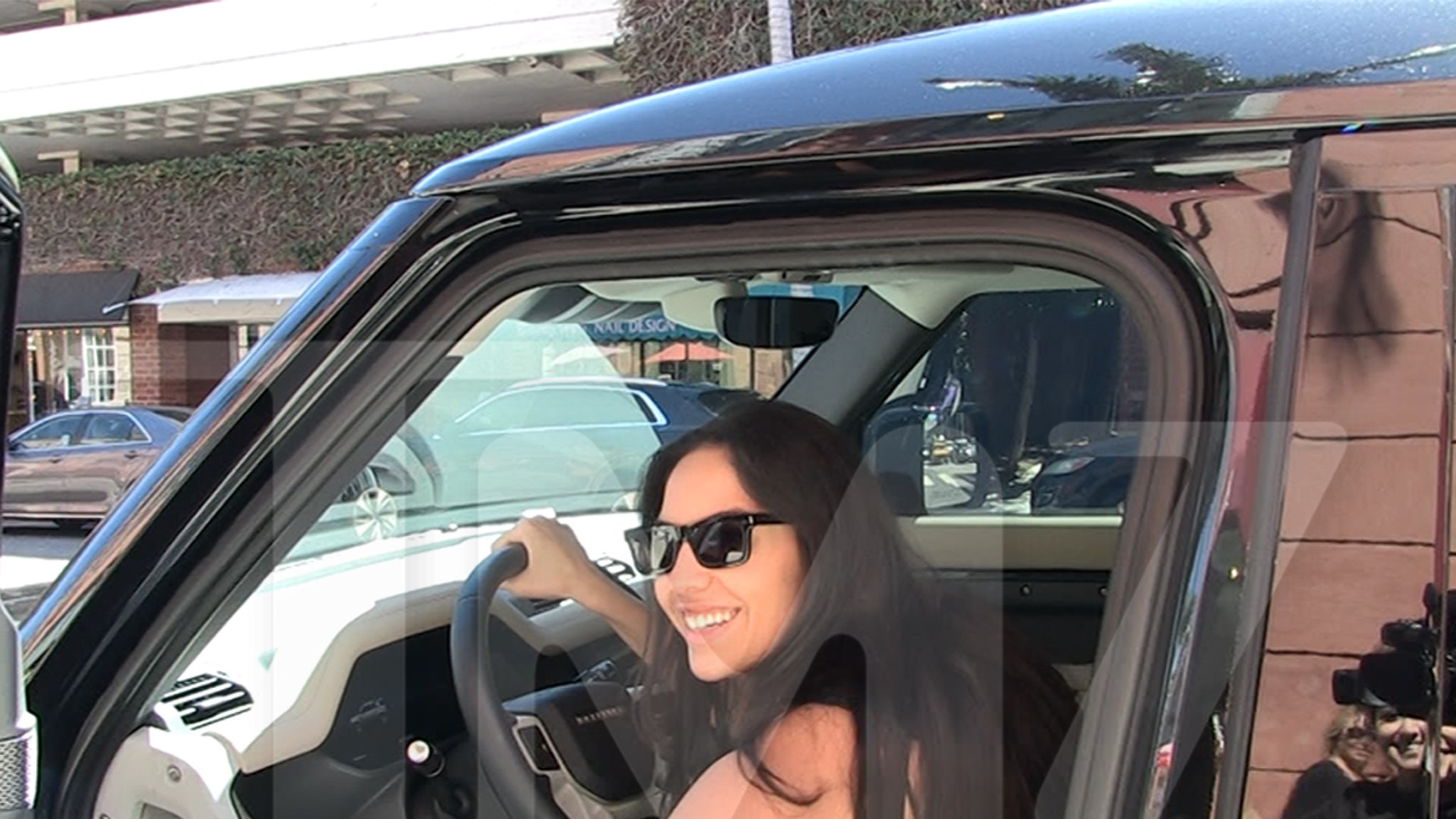
TMZ.com
Al Pacino‘s GF Noor Alfallah heaped some serious praise on the acting icon’s fatherhood skills — but don’t be fooled … ’cause her stance on not tying the knot anytime soon hasn’t budged.
We caught up with Noor in Beverly Hills Monday … and she’s still singing the same old tune about not being the marrying type, telling us she’s just not sure about getting hitched.
Noor also mentions their young son is doing great … and basically looks like a mash-up of both her and Pacino.

NOVEMBER 2023
TMZ.com
It seems like one happy family … despite Noor sticking to her guns about not planning to marry her much-older boo Al — her position she first shared with us last year.
But they’re still happily together … Noor has full physical custody of Roman and shares joint legal custody of him … news TMZ first broke.
Lifestyle
'It's totally different': Younger tattoo artists are ditching the machine

Abby Ingwersen, a guest artist at Nice Try Tattoo, works on a client using the stick and poke method.
Mengwen Cao for NPR
hide caption
toggle caption
Mengwen Cao for NPR
For purveyors of an artform that’s famously permanent, tattoo artists sure like to switch things up.
In studios and shops around the world, younger artists are challenging the traditional ways of running a business and poking ink into skin.
From independent collectives to a revival of the so-called “stick and poke” tattoo, a new generation is leaving its mark.
A new studio structure
In a typical walk-in tattoo shop, there is an owner, some contracted artists and maybe an apprentice. The artists pay a percentage of their earnings to the owner in return for expertise, a place to work and a storefront to attract clients.
But some artists are forging ahead with a new, non-hierarchical vision: the independent studio, where the idea is to cut out the middle-man.
That’s where you will find Ella Sklaw, one of the five artists who works out of Nice Try Tattoo — a collaboratively-owned and operated tattoo studio they started three years ago with a friend in Brooklyn, New York.
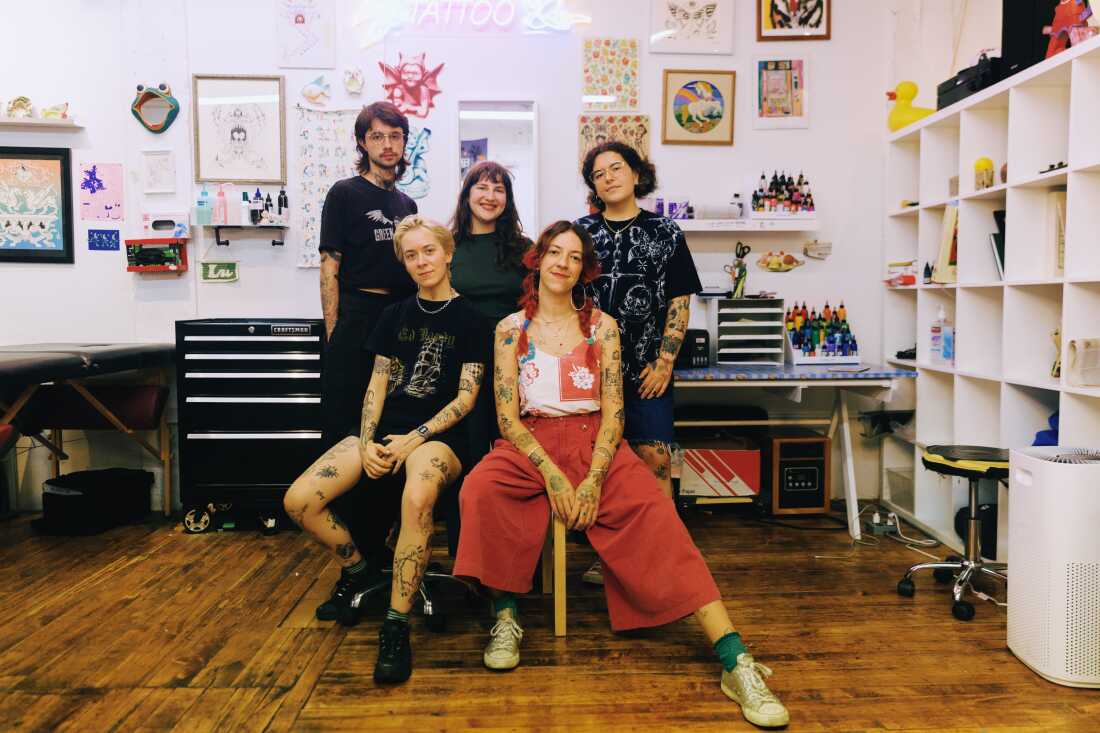
The members of Nice Try Tattoo, which includes (clockwise from top left) Cierson Zambo, Sydney Kleinrock, Ella Sklaw, Sara Sremac and Lu Walstad.
Mengwen Cao for NPR
hide caption
toggle caption
Mengwen Cao for NPR
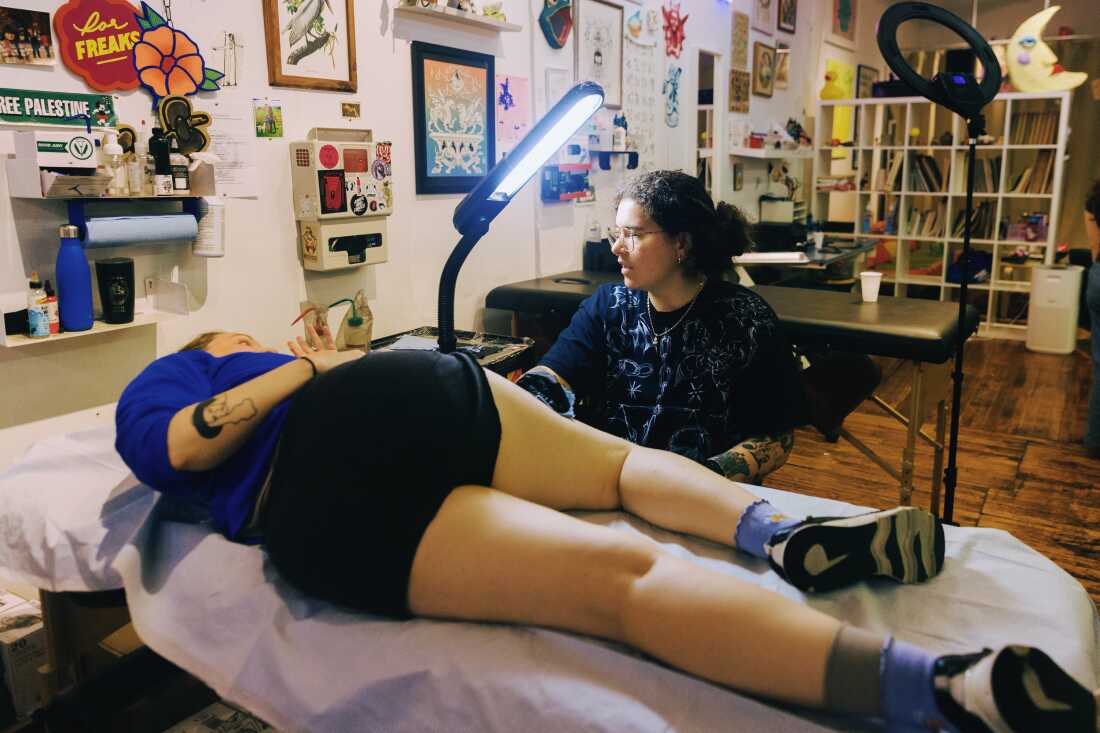
Ella Sklaw talks through the process with their client, Maddie Dennis-Yates.
Mengwen Cao for NPR
hide caption
toggle caption
Mengwen Cao for NPR
From the outside, Nice Try Tattoo is an unassuming warehouse. But once you enter, you’re met with comfy couches, walls plastered with thank you notes, and a wooden dining table in the back.
“We visually decorate the entire shop together,” Sklaw says. “We try to keep it super warm and super inviting. I think we really go for this idea that you should have stuff to look at while you’re getting a tattoo, because it hurts.”
For Maddie Dennis-Yates, one of Sklaw’s clients on a recent summer day, those touches are appreciated.
“There’s been a real shift in the vibe of tattoo studios lately,” Dennis-Yates says. “Even just having it in a building like this, it’s got this certain coziness to it. Like, you have to go find it somewhere, you can’t just stumble in off the street.”

For an array of reasons, the pandemic contributed to the rise of independent studios — some artists took up the skill during lockdown, while some clients found extra money or the confidence to get inked. And while there isn’t complete data on the number of independent studios versus traditional shops, the industry as a whole grew a steady 2.5% a year from 2018-23, according to research from IBISWorld.
The move towards independent work models is a symptom of something larger, especially for artists and creatives who have been the most historically exploited, according to Trebor Scholz, a New School professor who researches cooperative entrepreneurship.
“We have seen the increase during the pandemic, but this is something that is part of a much longer shift in the way work has performed over the past 50 years really, and these kind of non-standard work arrangements,” he said. “I don’t think the clock will be turned back on them.”
A “stick and poke” revival
Along with a shift in the business model there are also evolving styles and tastes — both from customers and artists.
Some artists at Nice Try Tattoo have left the machine behind and rely on a singular needle to etch their designs. It’s a method often called “stick and poke” or “hand poke.”
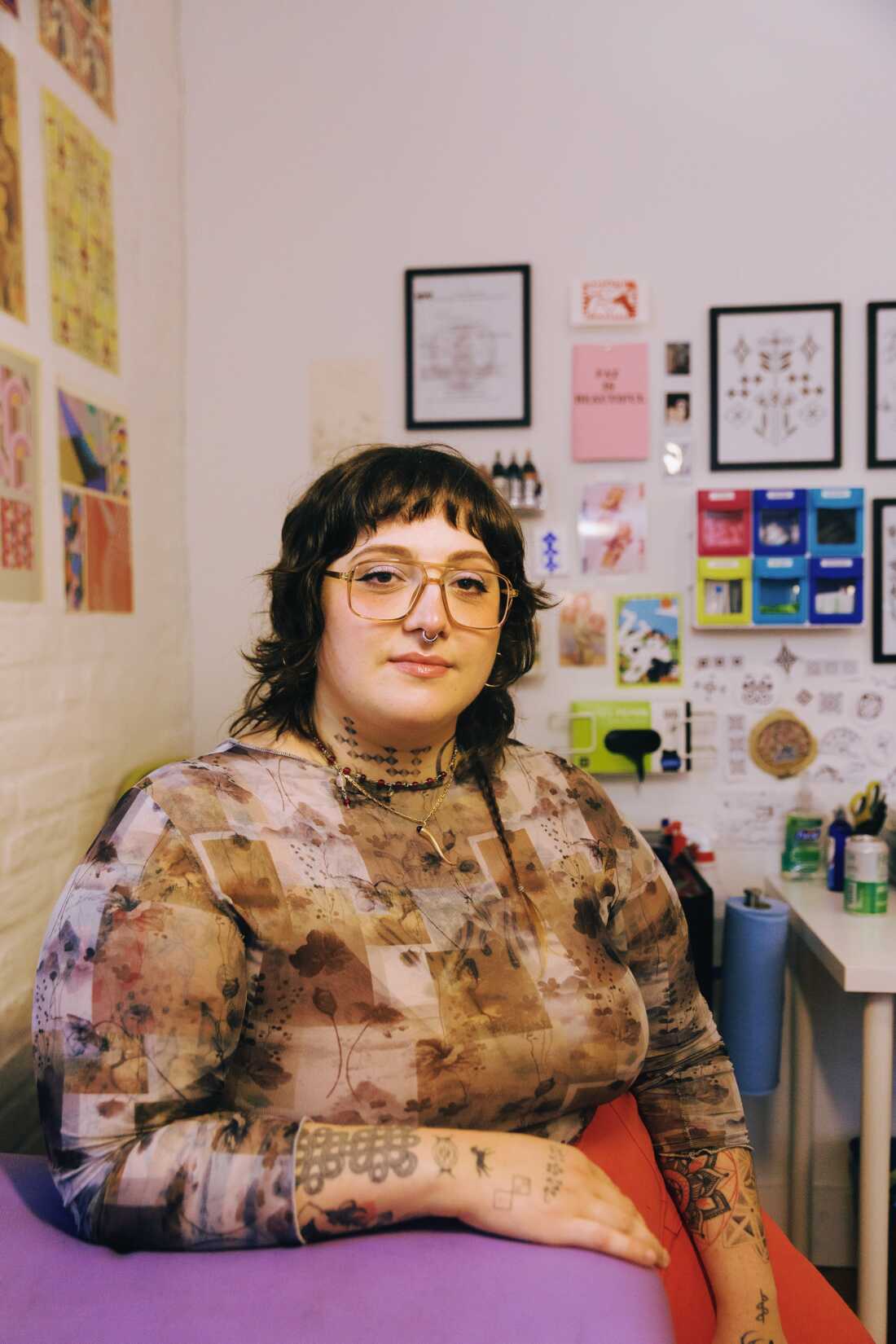
Nicole Monde works out of a private studio in Brooklyn.
Mengwen Cao for NPR
hide caption
toggle caption
Mengwen Cao for NPR
“I just take the needle and I just put it in my hand and then I just poke the design dot by dot,” says Nicole Monde, a hand poke artist who shares a private studio space in Brooklyn. “It’s very similar to machine in that it’s going the same depth, I’m using the same ink, same supplies, same needles and everything, but I’m just taking the machine out of it.”
Hand poke tattoos can conjure up images of college dorm rooms or DIY mishaps, and Monde acknowledges it’s not always seen as legitimate.
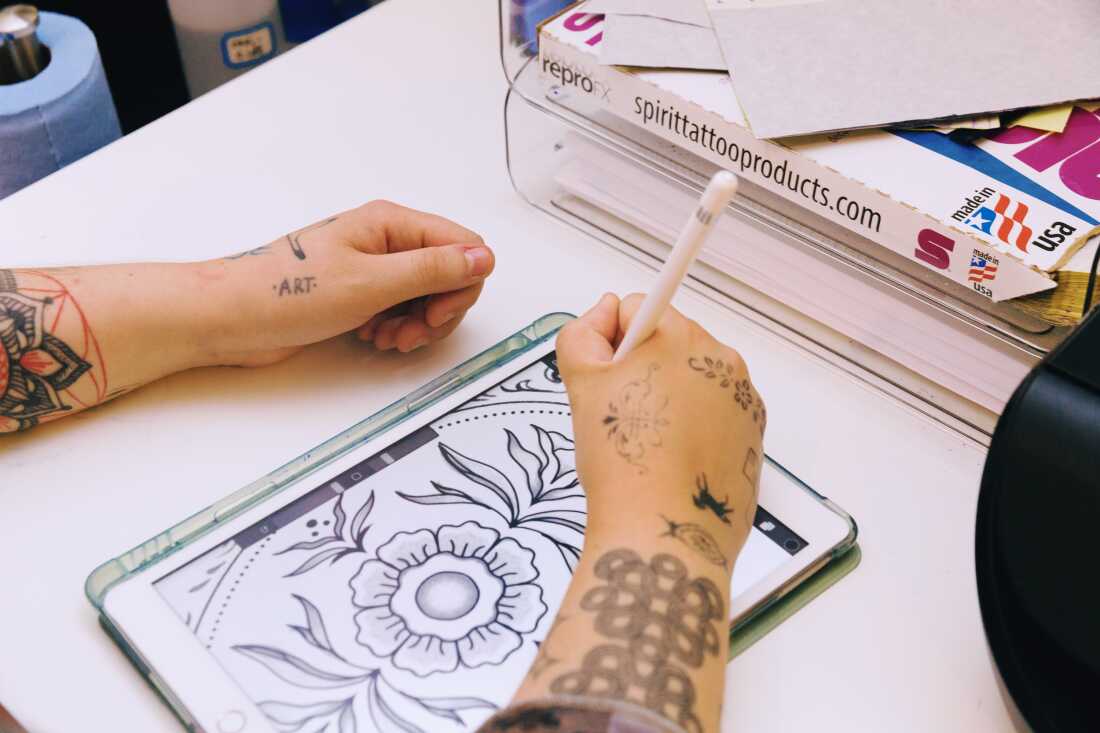
Monde puts together a tattoo design.
Mengwen Cao for NPR
hide caption
toggle caption
Mengwen Cao for NPR
“I think a lot of people don’t see it as a valid form of tattooing because the industry standard for so long has been using a machine. But I like to point out the fact that before electricity existed, this is how all tattoos were being done,” she says.
Some clients, like E Barnick, prefer hand poke tattoos for the overall experience.
“It’s totally different,” Barnick says. “I mean, it doesn’t hurt nearly as much and it’s also just a lot more intimate to have somebody hand poking.”

Still, some artists make the case that there are benefits to the traditional shop model that are lost when artists work out of independent studios and trade in different approaches.
“They’re missing out on the grander scale of experience and I think it’s harder to advance as an artist. I think you need that interaction with the average daily wacko wandering in off the street,” says Mehai Bakaty, who owned Fineline Tattoo in Manhattan until it was forced to close due to rising costs and the pandemic lockdowns.
Still, Bakaty now works from an independent studio as well, and says it takes him back to the 1990s when New York tattoo shops used to all operate under the radar because their operations were illegal and there were concerns about AIDS transmission.
“Sort of underground, clandestine, appointment-only, word of mouth, no advertising, no storefronts,” he says.
It’s not lost on Sklaw, from Nice Try Tattoo, that their collective studio model has come full circle back to these same ideas: word of mouth. No storefronts. No walk-ins.
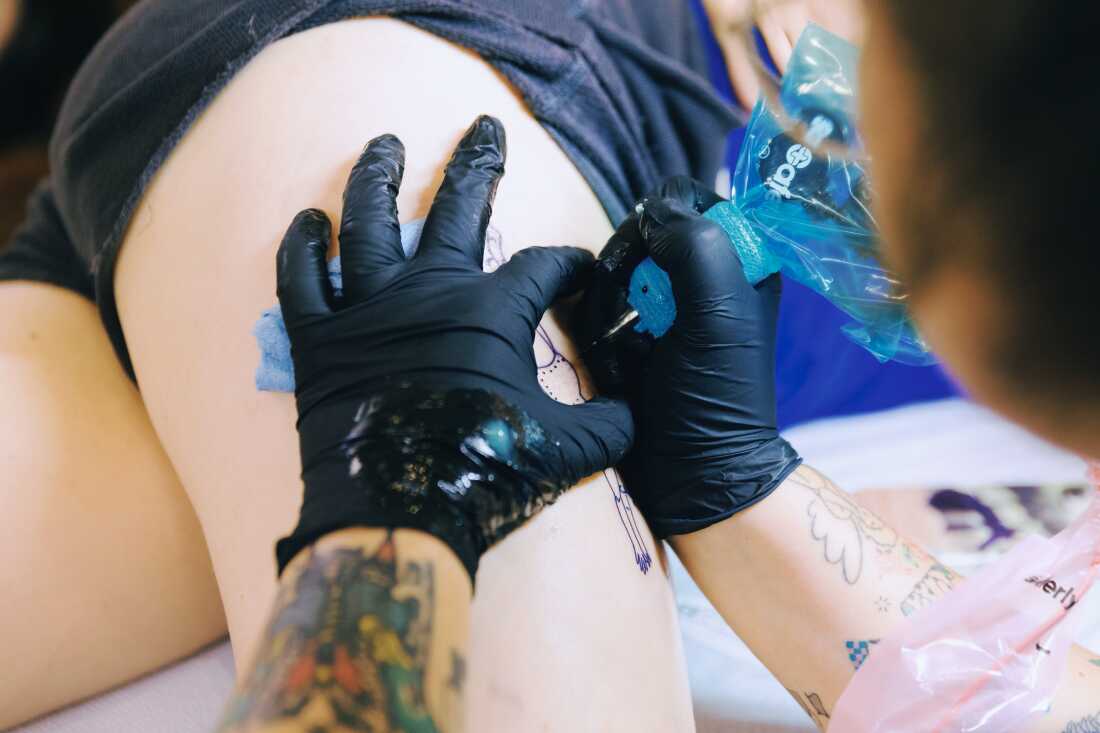
Sklaw works on a client.
Mengwen Cao for NPR
hide caption
toggle caption
Mengwen Cao for NPR
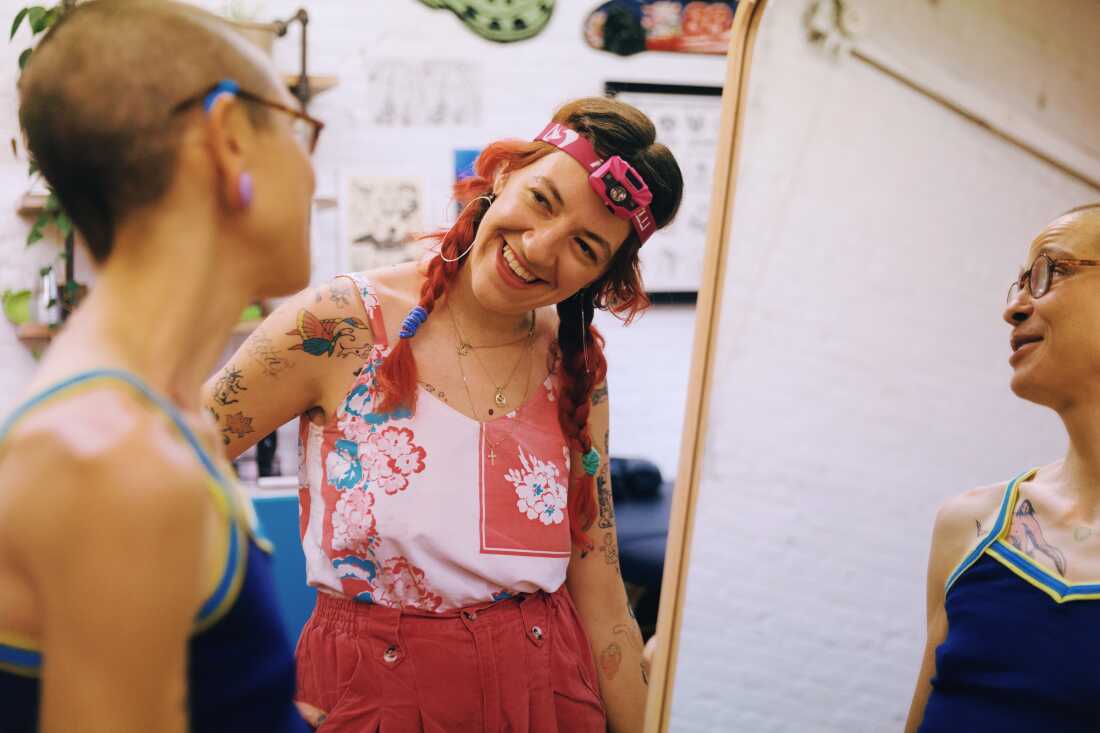
Artist Sara Sremac show her client E Barnick their new tattoo.
Mengwen Cao for NPR
hide caption
toggle caption
Mengwen Cao for NPR
“We kind of exist in the legacy of that alternative space,” Sklaw says.
These days, whether clients choose a machine or hand-poked tattoo, at an indie studio or a shop, the goal is the same: distinctive, meaningful, permanent art.
“Tattoos, I mean, cross-culturally, were always something to be extremely proud of,” says Lars Krutak, a tattoo anthropologist. “Because we’re talking primarily these … identify you as a member of a community.”
So when clients leave Nice Try Tattoo or a traditional shop, they aren’t just coming home with a new tattoo. The marking is a symbol of a community much larger than a singular artist or a singular needle.
Lifestyle
After 25 years, I wanted to quit drinking and couldn’t. Here’s how I finally got sober

“Want a glass of wine?” my friend yelled at me down the hall, yanking a cork out of a wine bottle. My writer’s group had rented a lake house in Vermont this past June on an island in the middle of Lake Champlain, where shorebirds and ducklings paddled past.
The thought of relaxing at the firepit in an Adirondack chair with an ice-cold glass of rosé made me salivate, the way my dog does when I pull the lid off the treat jar. Any other time, I would’ve had a glass (or two), but I was trying out sobriety.
For years, I toyed with the idea but couldn’t ever seem to do it until my drinking started to keep me up at night. I tried natural sleep supplements and acupuncture but neither worked.
At 44, I didn’t drink enough to experience major hangovers like I did when I was a journalist in my 20s living in New York City. And though I imbibed nightly during the initial throes of the COVID pandemic, I’d recently cut way back. When I unexpectedly hit perimenopause in my early 40s, my body began reacting to alcohol differently. Even if I had just one glass of wine, I’d wake up multiple times during the night. I suppose I could have avoided those moonlight bathroom trips with a sleeping pill, but that would have only masked the bigger problem: I wanted to quit drinking and couldn’t.
“People’s relationship to alcohol changes at different stages in life.”
— Elaine Skoulas, L.A.-based marriage and family therapist
I wrote about my frustration in my journal. Was a Thursday night Grey Goose martini worth the three cappuccinos I’d need to shake off brain fog on Friday morning?
I was not alone in my sudden questioning of a lifelong habit. Elaine Skoulas, a licensed marriage and family therapist based in L.A. who specializes in addiction, said it’s not uncommon to reevaluate your drinking habits as you age.
“Often I hear how much people’s relationship to alcohol changes at different stages in life,” said Skoulas, who has been sober for 12 years. Whether it’s due to aging or a change in metabolism, many people slow down their alcohol consumption as they get older because the negative effects of drinking worsen over time, she said.
But what would quitting do to my personal life? Alcohol was entwined with some of my biggest life milestones. I met my husband at a bar over a Northern Standard cocktail and then wrote about it for Food & Wine magazine. I received a bottle of Vermont WhistlePig rye for my 40th birthday and a Merry Edwards Russian River Pinot as a wedding present. And I did unabashedly love to drink — Miraval rosé under the summer stars, mezcal margaritas on lazy Saturday afternoons, boozy Bloody Marys with scrambled eggs and croissants on Sunday mornings.
If alcohol hadn’t started affecting my sleep, I probably would have never given it up. I didn’t even stop when my husband and I started fertility treatment in 2020. Ordering a cozy whiskey cocktail at my favorite local bar dulled the disappointment of every IVF failure.
I don’t think anyone would have called me an alcoholic, but I knew I had a problem when I realized how often I was writing in my journal about how crappy wine made me feel.
Then last December, an astrologer told me that my chart suggested I could benefit immensely from giving something up. It made me think about how I was only 7 years old when I stopped eating meat. I’d managed to stick with it my entire life.
Could I give up alcohol too? Christmas was just around the corner. I worried that my friendships would suffer. And what would my husband and I do for fun if we couldn’t go to our favorite bar on the weekend?
I finally reached my breaking point in March when I met two friends out for dinner. We all ordered drinks, then spent most of the meal discussing our not-so-great relationship with alcohol. I slept terribly that night and decided the next morning to try and stop for good.
I was tired of feeling guilty for giving my body something that made it miserable, tired of strategizing and rationalizing my alcohol consumption and tired of trying to get my brain to focus with so little sleep.
My husband was supportive, and so were my friends. I was lucky. Skoulas says having a reliable circle of loved ones can make all the difference in staying sober.
“It creates a sense of accountability because if you’re trying to get through an event on your own and nobody knows, of course it’s easier to reach for alcohol than if you have a friend standing next to you who knows that you weren’t planning to drink for the night,” she said.
“It’s kind of like a jet airliner: It takes a lot of energy to get it up into the sky, but once you get there, it’s much easier to manage.”
— Steve Kobashigawa, L.A.-based marriage and family therapist, on getting sober
I couldn’t have picked a worse time to try out sobriety. One week in, I attended a funeral for a woman in my writer’s group, then went out for dinner later that night, where I kept replaying the events of the day. I was grieving her absence, and I urgently needed a drink to take away some of the sadness. I leaned toward my husband.
“Maybe we could split a drink?” I asked.
“Do you really want one?” he replied.
I did. Anything to take away my emotional pain. But then I thought about the next morning. My sadness would still be there, and even harder to process on poor sleep. By the time we saw our waiter again we had finished our meal, and my wave of wanting had passed.
The following weeks were really hard. I was still waking up in the middle of the night, and it felt like I was competing against my own desires. I drank seltzer at weddings and took my 83-year-old father to stressful doctors’ appointments without later unwinding with a martini. When my friend’s fiancée took his own life, I was surrounded by wine bottles strewn across the kitchen counter, but each time I walked out the door stone-cold sober, I could breathe a sigh of relief.
Steve Kobashigawa, a marriage and family therapist based in L.A., said that when you feel a craving come on, do what you need to do to get into a more positive headspace. Call someone, journal or use a mindful drinking app like Sunnyside. Sometimes avoiding alcohol can seem impossible, but staying sober gets “exponentially easier” over time, he said.
“It’s kind of like a jet airliner: It takes a lot of energy to get it up into the sky, but once you get there, it’s much easier to manage,” said Kobashigawa, who specializes in addiction treatment and has been sober for 25 years.
Skoulas advised staying away from places where you used to drink regularly while you set new, healthful patterns and rewire your brain. If you go back to where you used to drink, even if you don’t have alcohol, your brain still experiences some of the more euphoric parts of drinking, which can be triggering.
“When you walk into familiar places, some of those neurotransmitters start to get released,” she said.
I learned that if I’m going to be around drinkers, it’s best to plan ahead. When I went away with my friends to the lake house, I called my local cocktail bar ahead of time and asked if they could make me a nonalcoholic beverage to-go. I felt silly doing it, but they told me that my order wasn’t all that unusual.
I had a great time that weekend, even though I was the only sober one in the group. Sometimes when people ask why I’m not drinking, it’s easier to say that I’m suffering from insomnia than it is to talk about my complicated relationship with alcohol.
Recently, a friend asked why I wasn’t drinking.
“I’m just taking a break,” I said. She responded with a sly smile — she knew I’d tried IVF before.
“I’m not pregnant,” I said, surprised that I could talk about my infertility without getting upset. That’s when I realized how much alcohol — a depressant — had been affecting my mood. A cocktail could only mask the pain for so long. I eventually had to face reality.
Alcohol provides a surge of dopamine and when that’s taken away, you initially might feel sad, but that usually fades within a few months, Kobashigawa said. Sometimes giving up drinking involves anhedonia, which is an inability to find pleasure in the activities you once enjoyed. But you can help avoid that feeling by keeping active.
“If you’re feeling flat, it’s unfortunately part of the recovery process, but try to take a walk or re-engage in the activities that used to be pleasurable for you,” he said.
In a few months, I’m going to Italy on my honeymoon. I had thought I’d want to spend evenings there imbibing with a Super Tuscan wine, but now I’m not so sure. These days, I feel more like myself. I’ve lost weight and have fewer wrinkles. Sobriety, it turns out, is way cheaper than Botox. It’s hard to imagine going back to how things used to be.
I had always thought that if I gave up my weekend martinis, I’d be imprisoned by the desire to drink, but here I am — sober for almost five months. Aside from the occasional craving, I don’t really think about alcohol. I drink raspberry shrub cocktails when I vacation with my girlfriends and go out for ice cream with my husband on the weekends. I’m less anxious and more present in conversations and in the world around me. In sobriety, I actually feel freer than ever.
Betsy Vereckey’s’ debut memoir is forthcoming next summer from Rootstock Publishing. She lives in Vermont with her husband and four boisterous terriers.
-

 Ohio6 days ago
Ohio6 days agoOhio taxpayers sent families $966 million for private school tuition: Capitol Letter
-
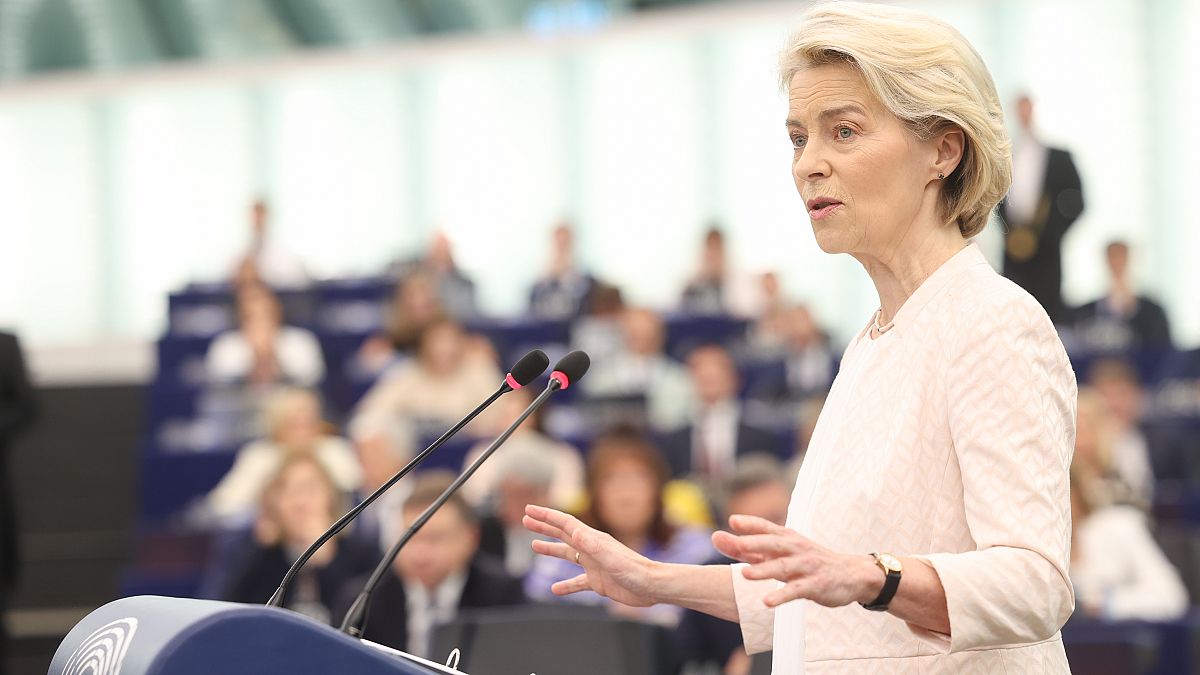
 World1 week ago
World1 week agoWhat could an EU Commissioner do to tackle the housing crisis?
-
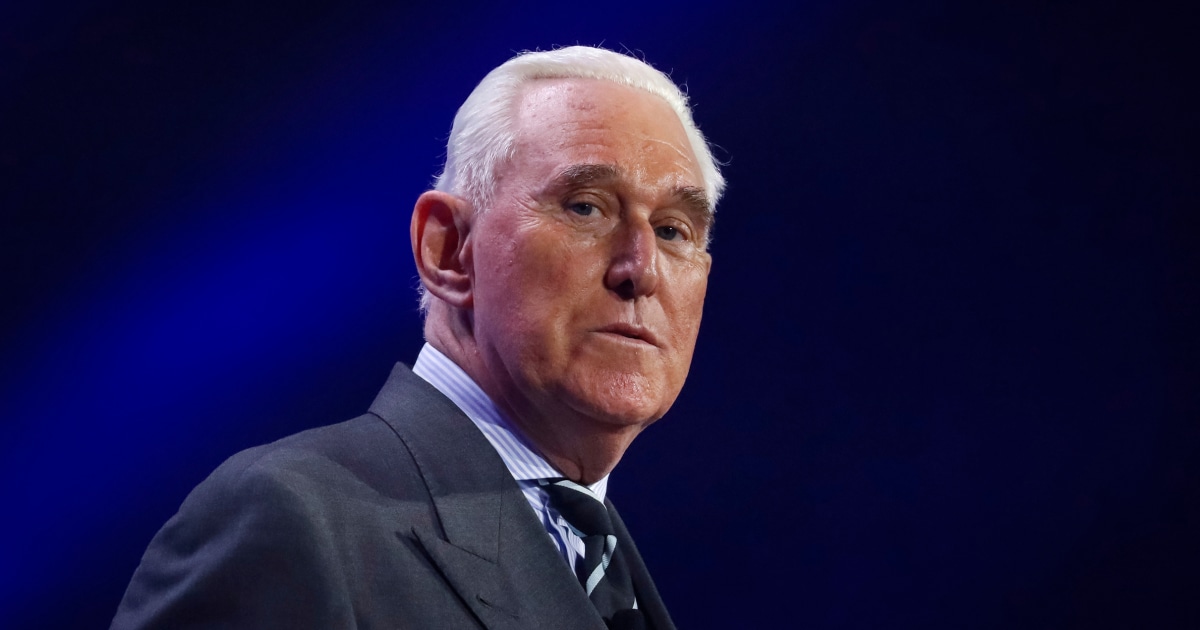
 News7 days ago
News7 days agoRoger Stone says his email accounts were how the hackers got into the Trump campaign
-
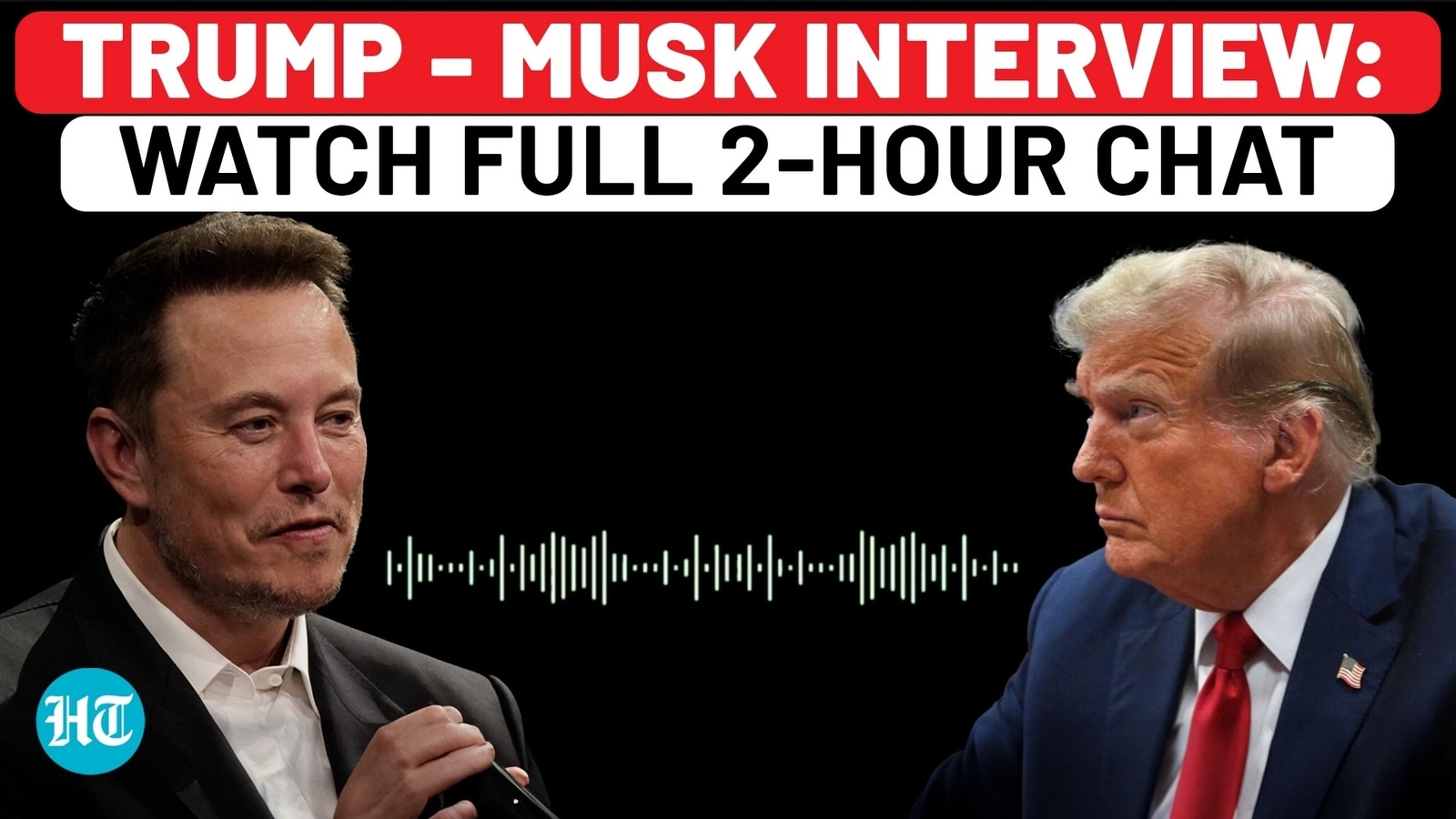
 News1 week ago
News1 week agoFull Trump-Musk Interview: Assassination Bid, Iran-Israel, Russia-Ukraine, Kamala-Biden, US Election
-
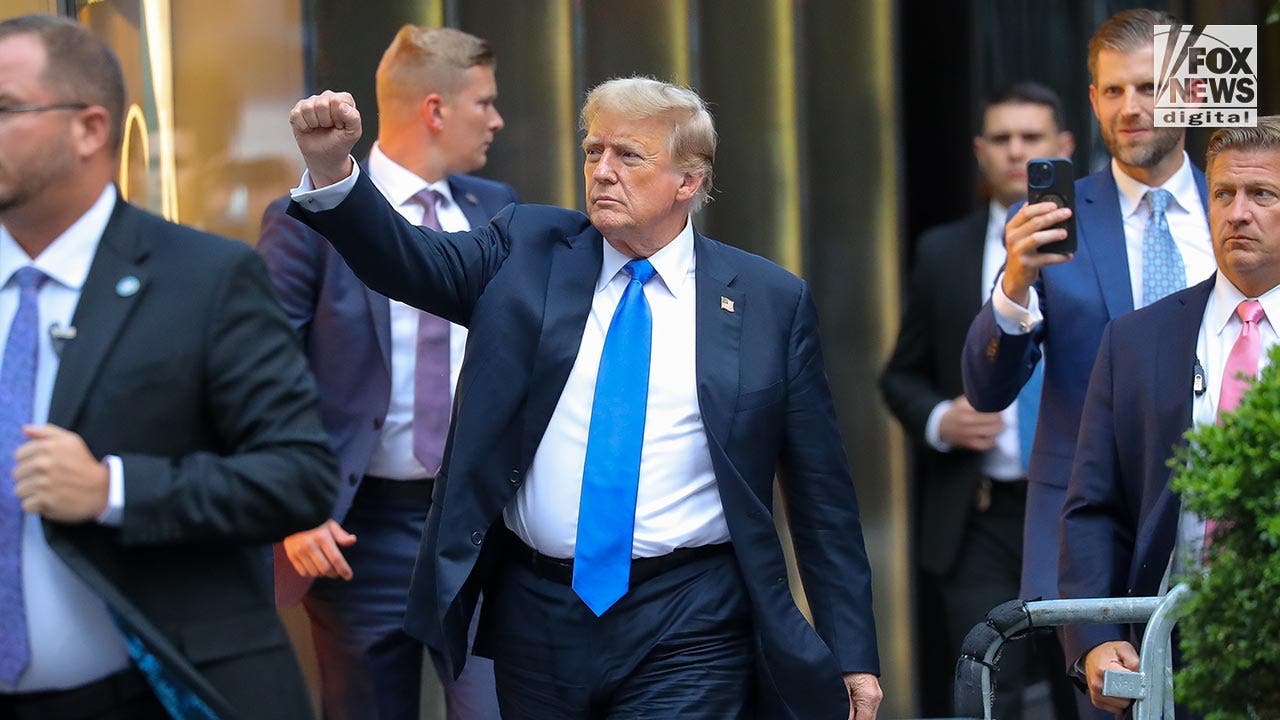
 Politics1 week ago
Politics1 week agoTrump legal cases in limbo after SCOTUS immunity ruling, freeing up schedule to campaign
-

 Science7 days ago
Science7 days agoOpinion: A route to safer chemotherapy
-
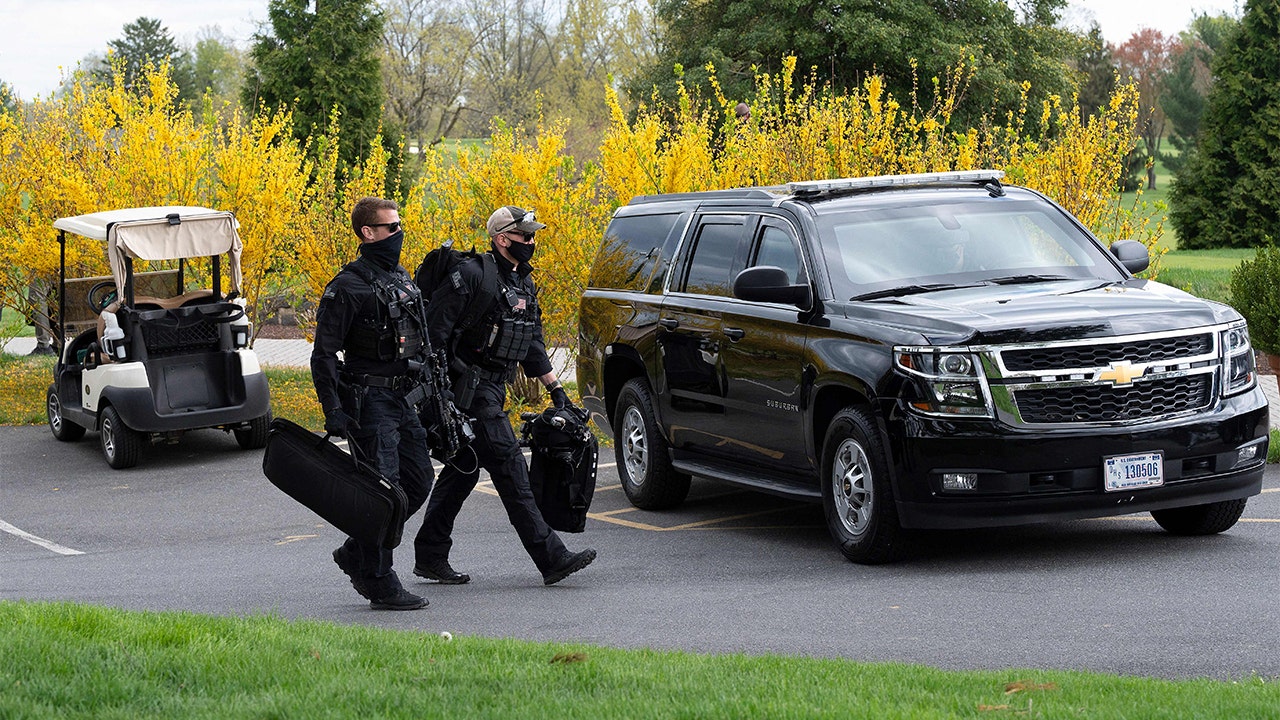
 Politics1 week ago
Politics1 week agoSecret Service apologizes after breaking into Massachusetts salon to use bathroom before Harris fundraiser
-
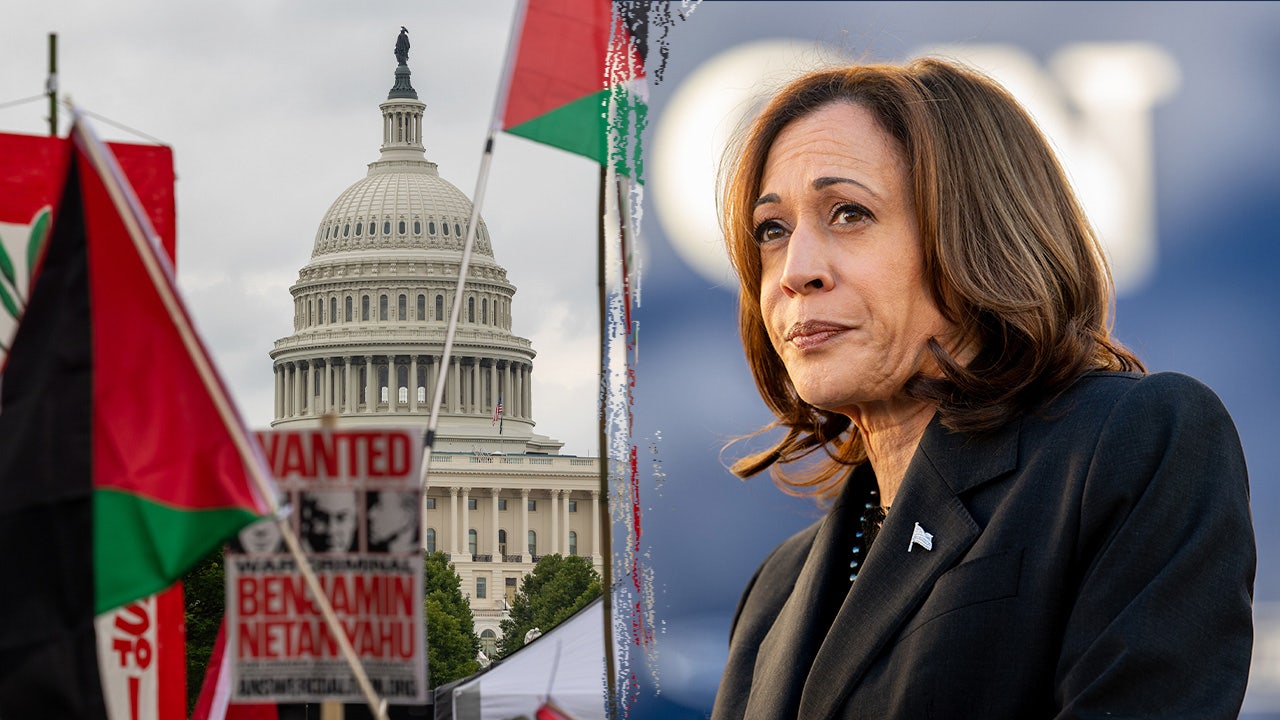
 Politics1 week ago
Politics1 week agoHarris voters defend Democratic presidential nominee on Israel-Hamas conflict: ‘She’s married to a Jewish guy’










